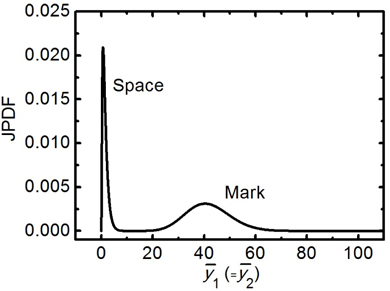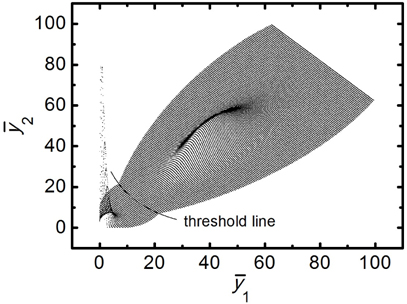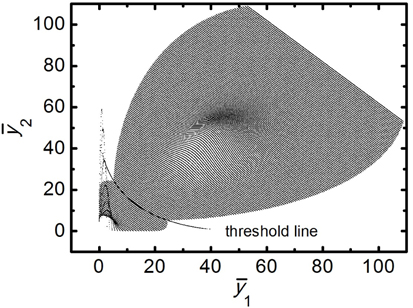



Recently, software-defined networks that can provide practical ways of handling multi-standard environments have been investigated extensively [1, 2]. In a similar way, software-defined optical receivers are under development in optical fiber communication systems to satisfy many different kinds of modulation formats and baud rates [3, 4]. Although coherent optical systems have become more practical than during their early stages, currently deployed optical transmission systems are mostly the intensity-modulated and direct-detection (IM/DD) type.
Conventional optical receivers for IM/DD systems use a single data per single bit for the decision [5] and require clock recovery circuits. If we could use multiple data for the decision, we do not need the clock recovery circuits [4] while enhancing the receiver sensitivities. However, there are no analyses, to our knowledge, about the correlations between two adjacent data from an optical receiver.
In this paper, we propose to use correlations of two adjacent data for the decision in direct-detection optical receivers. Using the receiver eigenmodes [6-12], we derive the joint characteristic function (JCF) for two successive data from an optical receiver and evaluate the corresponding joint probability density function (JPDF) [13]. The receiver eigenmodes can describe accurately the effects of the amplified spontaneous emission (ASE), received optical waveforms, and shapes of optical and electrical filters within the receiver [7]. Recently, receiver eigenmode contributions have been analyzed as a function of time for the optical receiver output [12]. It has been found that, in conventional dense WDM systems [14-17], where the channel spacing is comparable to the bit rate, the lowest-order (0-th) receiver eigenmode contributes dominantly. We will use this fact to find the correlations of two adjacent data and the threshold line for the decision to get higher sensitivities than conventional receivers.
II. JOINT CHARACTERISTIC FUNCTION
Before the derivation of the JPDF, we derive the JCF first. We will consider two adjacent samples at times
where
We normalize
where the denominator is the noise power per receiver eigenmode per polarization. Similarly, we have the normalized voltage at
The correlation function,
where
where
where
For the Gaussian vector,
Thus the JPDF for
The JCF for and can be written as
where
where
where
III. JOINT PROBABILITY DENSITY FUNCTION
The JPDF of and can be found from the twodimensional Fourier transform
When the signal is absent, the JCF becomes
which gives the JPDF of and in an exact form
where
If the two data are independent, we find from (22)
This JPDF is just a product of each sample’s PDF. To find (24), we have increased
where
The remaining integral can be done using a fast-Fourier-transform algorithm.
We may use the asymptotic form for the Bessel function, , and evaluate the integral of (25) using the method of steepest descents [18], which gives
The complicated expression of (27) is valid when the correlation is low (
For our analysis, we use a Gaussian optical receiver [11, 12], where both optical and electrical filters are Gaussian. We assume
Figure 1 shows two JPDFs evaluated numerically along the = line for
In Fig. 2, we show the foregoing JPDFs in a 3-dimensional way. It has been obtained by adding the JPDFs’ functional values to after multiplying a constant 4×103. Only the points, where at least one of the JPDFs is larger than 10-10, are shown. The JPDF for the space has been scaled down by the factor of 10 here also. Since
If the two sampling points are
In order to use the threshold line for the decision, we need analog-to-digital converters (ADCs) and digital signal processing (DSP) circuits instead of conventional D-flip-flop type decision. The speed of ADC and DSP circuits has been increased remarkably up to coherent 200 Gb/s per channel during recent years [19]. Realizations of software-defined optical receivers using these devices are now technically feasible and our JPDFs can be used to upgrade their capabilities for IM/DD channels.
We have derived the JPDFs for two voltage data from direct-detection optical receivers in dense WDM systems. We have shown that, with our JPDFs, we can reduce the BER and enhance the receiver sensitivities by 0.5 dB ~ 2.4 dB. Our decision method can be used for software-defined optical receivers supporting both coherent and intensity-modulated channels simultaneously.


